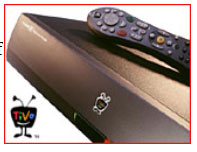Where We Are Now and Where They Want To Take Us
(or, How Else Can We Make Money from This?)
The current state of entertainment in the household is completely one-directional. This model has been effective for many decades, relying heavily on Nielsen television ratings to weigh the success of shows. More successful television shows (especially in the teenage age groups) lead to higher demand for advertising, which lead to more coveted commercial slots. Television makes most of its revenue from advertising.
However, advertisers have come to the realization that targeted advertising leads to a higher buy rate. In order to target consumers though, something needs to be known about them. Advertisers often look at a television show's content and average aggregated statistics (income, education level) to get a grasp on what advertising would be most effective. It is because of this, advertising found on MTV's Total Request Live is significantly different than NBC's Meet the Press.
The more you learn about the consumer, the more targeted your advertising can become. Unfortunately, this requires interaction on the consumers’ part and for decades they have been trained to only sit and absorb advertising. Corporations have been trying to bring interaction into the living room, with notable focus on the Internet.
One failed attempt at this is WebTV. In September 1996 Sony and Phillips introduced the first WebTV set-top boxes. Eventually it was bought by Microsoft in August 1997, and its offerings were extended to provide more Internet functionality through the television. WebTV envisioned a connected living room where people would email family members, browse the latest news sites and make their preferences known. They would capture the user's viewing habits and sell this information to direct advertisers to make some money (12). Even with the advertising, their main stream of revenue was the $20 monthly fee.
Everyone assumed that WebTV's growth would explode. Assuming that since the Internet was popular and its growth was explosive and the television also grew at a phenomenal rate, why would anybody assume otherwise? Some studies even showed WebTV selling over 89 million units by 2004!(13) However, the truth after the dot-com bubble burst paints a far direr picture for WebTV. The market never grew beyond initial adopters and even today Microsoft is trying again with their third iteration, UltimateTV(14).
|
Microsoft believes that the reason WebTV didn't take off was because the software was bad and television's display is not adequate enough to show an entire page. The WebTV proprietary browser was notorious for not supporting simple HTML designs and for not being updatable. In the world of Internet Time this is a death sentence. For instance, even today WebTV does not support Java. A television is also a bad display medium for the Internet. The amount of text presented on an average web page can not be displayed cleanly on a low-definition television. Both of these problems confounded the adoption of WebTV.
|

The "Simple-to-Use" WebTV keyboard
|
Fundamentally Microsoft's WebTV was not a failure because of those issues they saw themselves. WebTV was a difficult device to use. The average American does not want to sit on his couch in the living room typing on a wireless keyboard. A keyboard is far from an intuitive interface, and in order to make a user more active you have to do so in a gentle and simple way. The Internet, as it stands, demands far too much activity (unintuitive activity at that) to be successful.
Microsoft eventually gave up on the promise of bringing the Internet to the living room. Most of their MSNTV (the WebTV division’s new name) employees have now been laid off. The few remaining have now been assigned to "next big thing" Ultimate TV, which is a digital personal video recorder (PVR.)
A PVR is a smart VCR. It records all the shows you tell it to, regardless of when they are, on a hard drive in the machine. Using your taste in shows, it offers suggestions of shows that might suit your taste and is also an excellent device for direct marketing. Microsoft's most serious competitor and the current market leader is TiVo. TiVo charges a monthly fee of $12.95 for its service, which also adds the ability to fast-forward, pause or rewind live television.

TiVo Personal Video Recorder
|
The TiVo has been far more successful than WebTV, but it still has not achieved ubiquitous market penetration. The most common TiVO subscriber is one who describes himself as "too busy to watch television” and is often far more active than the average television user(15). TiVO is still an active experience that requires an active user. It is far more intuitive than WebTV (it uses a remote control instead of a keyboard) but it still is far too unintuitive for the average consumer.
|
Any technology that wants to empower the user must be simple to use and captivating. It must demand interaction in a way a pencil or pen does. It must allow the user to express his creativity and it must encourage that creativity as well. The speculative design I will propose will try to address these issues and meet these prerequisites.
The second big innovation of the modern day television era is the introduction of digital broadcasting. Large bandwidth and new compression techniques have given the cable and satellite companies the ability to broadcast thousands of channels with high quality video and sound. Potentially, the cable companies can broadcast programming for everyone giving the consumer command to what is shown. Unfortunately, looking at the current digital cable landscape you find that there is nothing of interest on the air on any given day. With broadcasting ranging from the Soap Opera Network's 1987 All My Children reruns to four 24 hour news channels, the increased bandwidth has lead to nothing more than the same old thing, just many times over.
Instead of empowering the consumer, Digital Cable has given rise to a multitude of pay-per-movies being shown at staggered times during the month. The bandwidth has been misused and wasted, and channel operators are slowly discovering this as they see niche channels barely covering their costs. This misallocation and miscalculation of a valuable commodity is an error the cable companies might come to grips with in a few years. My speculative design is dependent on this excessive bandwidth.
nv27@cornell.edu
